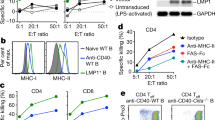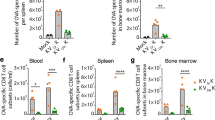Abstract
Cytotoxic T lymphocytes (CTLs) kill neoplastic or virally infected cells after recognizing on their surface antigenic peptides bound to major histocompatibility complex class I molecules. These peptides are derived from antigens that are degraded in the cytosol of the affected cell. Because exogenous proteins cannot enter the cytosol, immunizations with killed pathogens or their proteins do not generally elicit CTLs. However, antigens that are internalized into phagocytic cells can enter the cytosol and be processed for class I presentation. Here we show that immunization with a purified antigen on an avidly phagocytized particle primes CTLs, which in turn protect animals from subsequent challenge with tumours transfected with the antigen gene. Interestingly, these animals also become immune to other antigens expressed by the tumour. This approach could be exploited to develop tumour and viral vaccines.
This is a preview of subscription content, access via your institution
Access options
Subscribe to this journal
Receive 12 print issues and online access
$209.00 per year
only $17.42 per issue
Buy this article
- Purchase on Springer Link
- Instant access to full article PDF
Prices may be subject to local taxes which are calculated during checkout
Similar content being viewed by others
References
Yewdell, J.W. & Bennink, J.R. Cell biology of antigen processing and presentation to MHC class I molecule restricted T-lymphocytes. Adv. Immun. 52, 1–42 (1992).
Townsend, A. & Trowsdale, A. The transporters associated with antigen presentation. Semin. Cell Biol. 4, 53–61 (1993).
Doherty, P.C., Knowles, B.B. & Wettstein, P.J. Immunological surveillance of tumours in the context of major histocompatibility restriction of T-cell function. Adv. Cancer Res. 42, 1–65 (1984).
Rosenberg, S.A. et al. Use of tumour infiltrating lymphocytes and interleukin 2 in the immunotherapy of patients with metastatic melanoma. New Engl. J. Med. 319, 1676–1680 (1988).
Aebersold, P. et al. Lysis of autologous tumour cells by tumour infiltrating lymphocytes: association with clinical response. J. natn. Cancer Inst. 83, 932–938 (1991).
Singluff, C.L. Jr., Hunt, D.F. & Engelhard, V.H. Direct analysis of tumour associated peptide antigens. Curr. Opin. Immunol. 6, 733–740 (1994).
Pardoll, D.M. Tumour antigens: A new look for the 1990s. Nature 369, 357–358 (1994).
Boon, T. Toward a genetic analysis of tumour rejection antigens. Adv. Cancer Res. 58, 177–189 (1992).
Carbone, F.R. & Bevan, M.J. Class-I restricted processing and presentation of exogenous cell associated antigen in vivo . J.exp. Med. 171, 377–387 (1990).
Kaufmann, S.H. CD8+ T lymphocytes in intracellular microbial infections. Immun. Today 9(6), 168–174 (1988).
Pfeifer, J.D. et al. Phagocytic processing of bacterial antigens for class I MHC presentation to T cells. Nature 361, 359–362 (1993).
Kovacsovics-Bankowski, M. & Rock, K.L. Presentation of exogenous antigens by macrophages: analysis of major histocompatibility complex class I and class II presentation and regulation by cytokines. Eur. J. Immun. 24, 2421–2428 (1994).
Rock, K.L., Gamble, S. & Fleischacher, C. Characterization of antigen presenting cells that present exogenous antigens in association with class I MHC molecules. J. Immun. 150, 438–446 (1993).
Kovacsovics-Bankowski, M., Clark, K., Benacerraf, B. & Rock, K.L. Efficient major histocompatibility complex class I presentation of exogenous antigen upon phagocytosis by macrophages. Proc. natn. Acad. Sci. USA. 90, 4942–4946 (1993).
Harding, C.V. & Song, R. Phagocytic processing of exogenous particulate antigens by macrophages for presentation by MHC class I molecules. J. Immun. 153, 4925–4935 (1994).
Kovacsovics-Bankowski, M. & Rock, K.L. A phagosome-to-cytosol pathway for exogenous antigens presented on MHC class I molecules. Science 267, 243–246 (1995).
Pan, Z.-K., Ikonomidis, G., Lazenby, A., Pardoll, D. & Paterson, Y. A recombi-nant Listeria monocytogenes vaccine expressing a model tumour antigen protects mice against lethal tumor challenge and causes regression of established tumours. Nature Med. 1, 471–477 (1995).
Zhou, F., Rouse, B.T. & Huang, L. Prolonged survival of thymoma bearing mice after vaccination with a soluble protein antigen entrapped in liposomes: A model study. Cancer Res. 52, 6287–6291 (1992).
Huang, A.Y.C. et al. Role of bone marrow derived cells in presenting MHC class I restricted tumour antigens. Science 264, 961–965 (1994).
Kundig, T.M. et al. Nonimmunogenic tumour cells may efficiently restimulate tumour antigen specific cytotoxic T-cells. J. Immun. 150, 4450–4456 (1993).
Moore, M.W., Carbone, F.R. & Bevan, M.J. Introduction of soluble proteins into the class I pathway of antigen processing and presentation. Cell 54, 777–785 (1988).
Ulmer, J.B. et al. Heterologous protection against influenza by injection of DNA encoding a viral protein. Science 259, 1745–1759 (1993).
Rock, K.L., Rothstein, L. & Gamble, S. Generation of class-I MHC restricted T-T hybridomas. J. Immun. 145, 804–811 (1990).
Fidler, I.J., Gersten, D.M. & Budmen, M.B. in vivo and in vitro of tumour cells selected for resistance to syngeneic lymphocyte-mediated cytotoxicity. Cancer Res. 36, 3160–3165 (1976).
Watson, J. Continuous proliferation of murine antigen specific helper T-lymphocytes in culture. J. exp. Med. 150, 1510–1515 (1979).
Auchincloss, H. Jr., Ghobrial, K.R., Russel, P.S. & Winn, H.T. Anti-L3T4 in vivo prevents alloantibody formation after skin grafting without prolonged graft survival. Transplantation 45, 1118–1123 (1988).
Author information
Authors and Affiliations
Rights and permissions
About this article
Cite this article
Falo, L., Kovacsovics-Bankowski, M., Thompson, K. et al. Targeting antigen into the phagocytic pathway in vivo induces protective tumour immunity. Nat Med 1, 649–653 (1995). https://doi.org/10.1038/nm0795-649
Received:
Accepted:
Issue Date:
DOI: https://doi.org/10.1038/nm0795-649
This article is cited by
-
In vivo assembly of epitope-coated biopolymer particles that induce anti-tumor responses
npj Vaccines (2024)
-
Optogenetic engineering of STING signaling allows remote immunomodulation to enhance cancer immunotherapy
Nature Communications (2023)
-
Anticancer effects of chemokine-directed antigen delivery to a cross-presenting dendritic cell subset with immune checkpoint blockade
British Journal of Cancer (2020)
-
Therapeutic ISCOMATRIX™ adjuvant vaccine elicits effective anti-tumor immunity in the TRAMP-C1 mouse model of prostate cancer
Cancer Immunology, Immunotherapy (2020)
-
IL-6-mediated environmental conditioning of defective Th1 differentiation dampens antitumour immune responses in old age
Nature Communications (2015)



